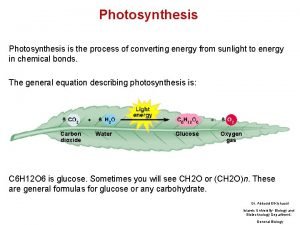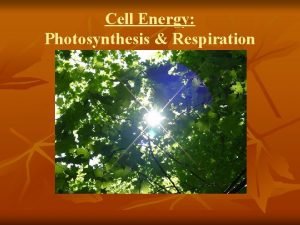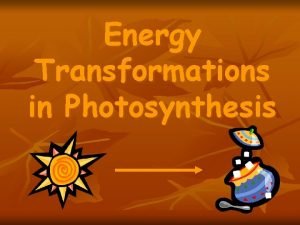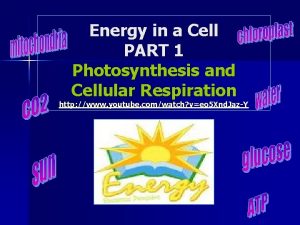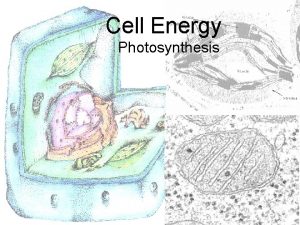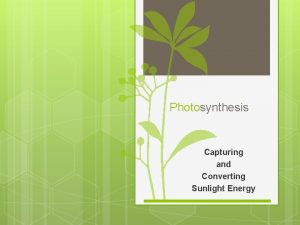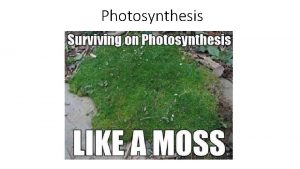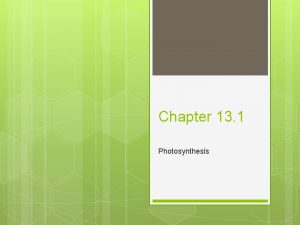CHAPTER 6 PHOTOSYNTHESIS CAPTURING CONVERTING ENERGY 2 PROCESSES










- Slides: 10

CHAPTER 6: PHOTOSYNTHESIS CAPTURING & CONVERTING ENERGY

2 PROCESSES OF PHOTOSYNTHESIS • Photosynthesis is actually 2 processes: • light reactions - convert solar energy (sunlight) to chemical energy (ATP & NADPH) • dark reactions (Calvin cycle) light independent reactions; use energy produced & stored during light reactions (ATP & NADPH) & incorporates CO 2 from air into organic molecules which are converted to sugar (glucose) 11/21/16 Biology: Photosynethesis 2

PHOTOSYNTHESIS • Photosynthesis takes place in chloroplast organelle. • contains photosynthetic membranes that contain chlorophyll • light reactions take place in photosynthetic membranes (thylakoids) • dark reactions take place outside photosynthetic membranes (stroma) 11/21/16 Biology: Photosynethesis 3

copyright cmassengale 4

Stage 1: Light-Dependent reactions, sunlight & water are absorbed by chlorophyll in the thylakoids & converted into chemical energy (in the form ATP and NADPH). What Goes In? (needed) Out? (produced) Sunlight Water ATP, NADPH Oxygen Energy is transferred along thylakoid membranes to be used for Light-Independent reactions

Stage 2: Light-Independent reactions (the Calvin cycle) occurs in the stroma and creates carbohydrates (sugar) from carbon dioxide & energy stored during the light-dependent reactions What Goes In? (needed) What Goes Out? (produced) ATP, NADPH Carbon Dioxide Glucose (sugar) which is stores in plant’s structures as cellulose

What is ATP? • ATP (Adenosine Triphosphate) stores energy until a cell needs it. When a cell requires energy, it breaks off the last (3 rd) phosphate group from the ATP molecule, which releases energy. The new molecules is called ADP (Adenosine Diphosphate) 1 11/21/16 Y RG 2 3 Biology: Photosynethesis E EN RE D! SE A LE 5

ATP AND GLUCOSE ATP Glucose Short Term Long Term Storage Transfers energy very quickly Takes longer to get energy out Can’t store energy very long. (breaks down to ADP and loses energy) Can store energy very well. 1 molecule of glucose can hold 90 x more energy than ATP.

WHAT IS PHOTOSYNTHESIS? 11/21/16 Biology: Photosynethesis 20

13. 1 Ecologists Study Relationships Critical Question: List the Reactants & Products of Light-Dependent Reactions and Light-Independent Reactions. Stage Reactants Products Light Dependent Sunlight, water Oxygen, ATP, NADPH Light Independent Carbon dioxide, NADPH, ATP sugar
 Photosynthesis is the process of converting
Photosynthesis is the process of converting Photosynthesis transforms light energy into chemical energy
Photosynthesis transforms light energy into chemical energy Concurrent processes are processes that
Concurrent processes are processes that How do plants get glucose
How do plants get glucose Energy energy transfer and general energy analysis
Energy energy transfer and general energy analysis Energy energy transfer and general energy analysis
Energy energy transfer and general energy analysis Radiant energy in photosynthesis
Radiant energy in photosynthesis Photosynthesis energy transformation
Photosynthesis energy transformation Cellular energy section 2 photosynthesis
Cellular energy section 2 photosynthesis Capturing kids hearts four questions
Capturing kids hearts four questions Capturing marketing insights examples
Capturing marketing insights examples
